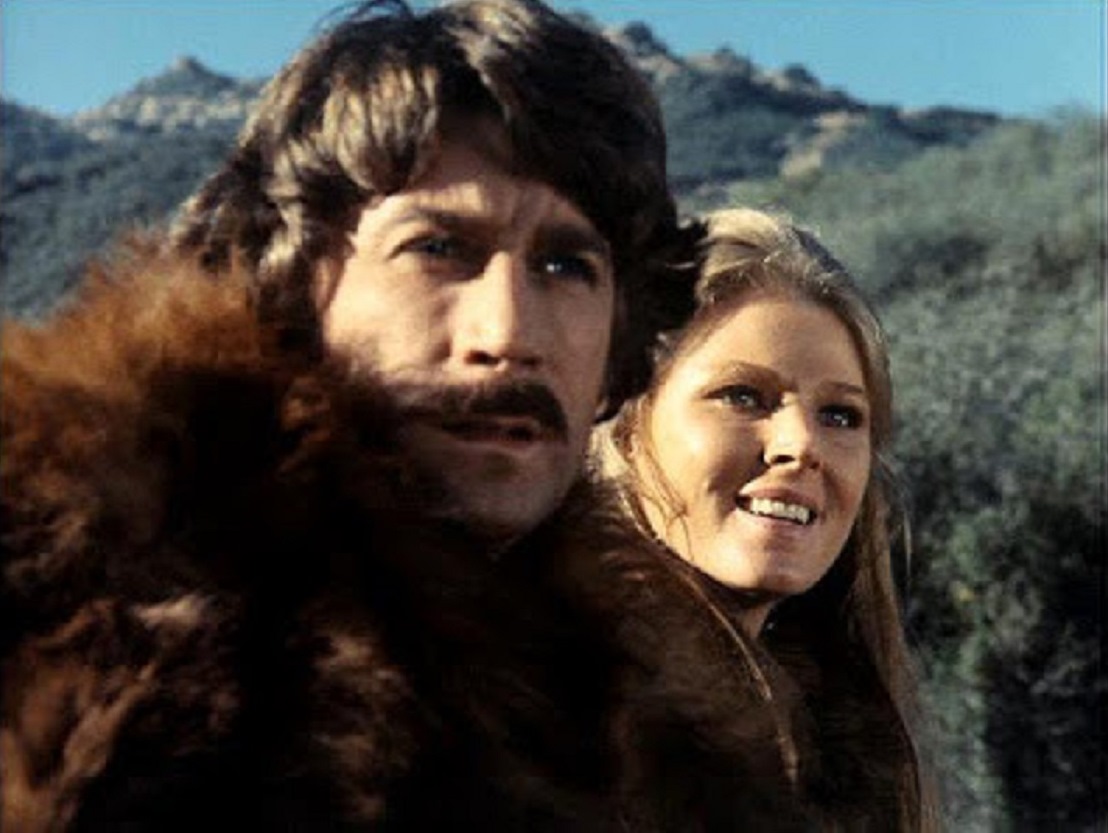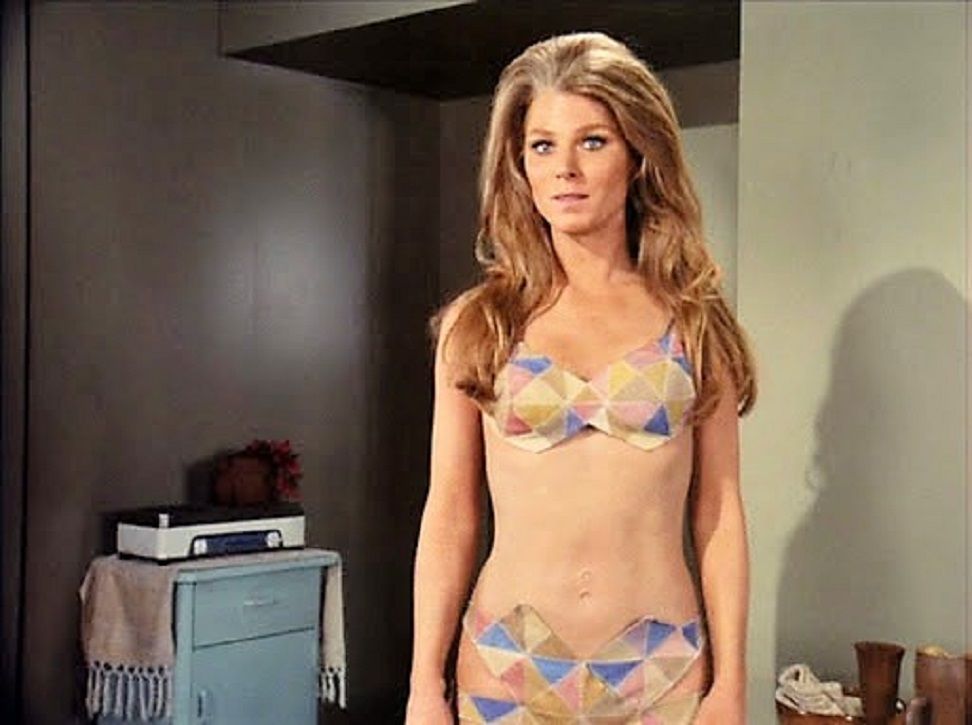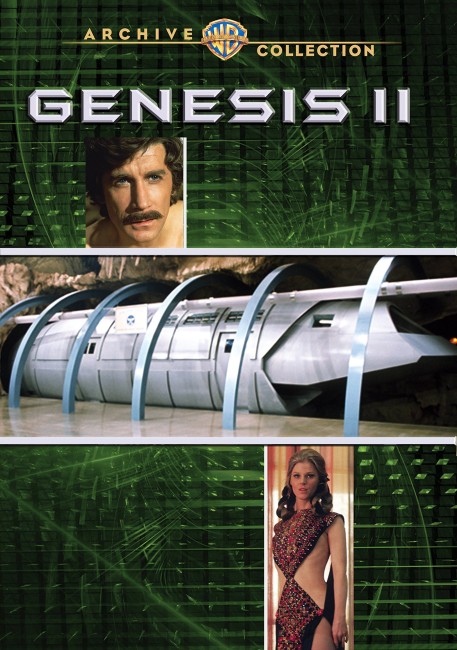USA. 1973.
Crew
Director – John Llewellyn Moxey, Teleplay/Producer – Gene Roddenberry, Photography – Gerald Perry Finnerman, Music – Harry Sukman, Makeup – Tom Burman, Art Direction – Hilyard Brown. Production Company – Norway Productions/Warner Bros. Television.
Cast
Alex Cord (Dylan Hunt), Mariette Hartley (Lyra-a), Ted Cassidy (Isiah), Percy Rodrigues (Primus Isaac Kimbridge), Titos Vandis (Primus Yuloff), Lynne Marta (Harper-Smythe), Harvey Jason (Singh), Bill Striglos (Dr Kellum), Majel Barrett (Primus Dominic)
Plot
In 1979, scientist Dylan Hunt is head of NASA’s Ganymede Project, which is trying to develop a means of cryogenic suspension for use in space travel. Hunt agrees to place himself in suspended animation in the project’s laboratory in the Carlsbad Caverns in order to test the device. However, an earthquake causes the cave to collapse and bury the laboratory. Hunt remains frozen there until he is revived in the year 2133 by members of the scientific organisation PAX. He emerges to discover a world where all that was familiar to him has been destroyed by nuclear war. Society has collapsed into small pockets of civilisation and it is the goal of PAX to unite these, using a network of subterranean shuttles that connect the world. Hunt is persuaded by Lyra-a, one of his discoverers who has nursed him back to health, that PAX is not as benevolent it seems and has global domination plans. Lyra-a persuades Hunt to return with her to her home city of Tyrania, which is ruled by her mutant people. Soon however, Hunt begins to see that the Tyranians are cruel despots that practice slavery and that their real reason in bringing him there is not to repair their faulty nuclear power station but to activate an arsenal of nuclear weapons.
Gene Roddenberry will always be the man who created Star Trek (1966-9). This single credit gave Gene Roddenberry an enormously revered position in science-fiction fandom. Unfortunately for Roddenberry, he ended up being a one-trick pony who had a big success once in his career and then spent the rest of his life trying to duplicate it. Throughout the 1970s, Roddenberry made several attempts to create another genre tv series. Certainly, some of the efforts that did make it to the camera felt like they were full of potential. These included the pilot films The Questor Tapes (1974) about an android searching for its purpose – something that later fed into the character of Data in the Star Trek: The Next Generation (1987-94) – and Spectre (1977) about occult investigators. The project that seemed the closest to becoming an actuality was Genesis II.
Outside of these pilots, Gene Roddenberry was left recycling the familiar. Star Trek was first reworked as an animated series Star Trek (1973-4). There were big plans to revive Star Trek for television from around 1977 onwards, involving most of the original cast bar Leonard Nimoy, before this transmuted into a theatrical film with Star Trek – The Motion Picture (1979). Unfortunately for Roddenberry, Star Trek – The Motion Picture was a deeply problem-ridden production where behind-the-scenes troubles and massive budget overruns caused it to become one of the most expensive films ever made at the time. Though the film was a more-than-reasonable box-office success, it failed to earn back the amount it cost to produce. Paramount blamed Roddenberry for its troubles and he was removed from direct involvement in the subsequent Star Trek films bar the obligatory ‘Based on Star Trek Created by Gene Roddenberry’ credit. Roddenberry was next brought back in to produce Star Trek: The Next Generation but this too became a problem-ridden production with a revolving door of creative personnel. Star Trek: The Next Generation largely found its feet around the third season when Roddenberry was sidelined and creative control of the show was taken over by others. Roddenberry died in 1991 and has subsequent the distinction of creating more tv series after his death than when he was alive – having been indirectly responsible for six further Star Trek series, Star Trek: Deep Space Nine (1993-9), Star Trek: Voyager (1995-2001), Enterprise (2001-5), Star Trek: Discovery (2017– ), Star Trek: Picard (2020-23), the animated Star Trek: Lower Decks (2020- ), Star Trek: Prodigy (2021- ) and Star Trek: Strange New Worlds (2022- ), as well as the original series Earth: Final Conflict (1997-2002) and Andromeda (2000-5).
With Genesis II, Gene Roddenberry was clearly attempting to create another Star Trek. Roddenberry was an ardent humanist and often wrote episodes that were preachy social parables. Star Trek frequently employed a didactic storytelling form where each week The Enterprise would visit a planet that would represent a different form of society (child-rule, computer-rule, women-rule, the troubles with godlike beings and Utopias, analogues of the Roman Empire, the Vietnam War, the Wild West and Nazis, even Prohibition-era Chicago ruled by racketeers), which Captain Kirk and crew would then topple and lecture the people on the principles of Jeffersonian democracy.

Genesis II was simply Gene Roddenberry creating another series that allowed him to do the same thing – the good guys being an enlightened humanist society that valued science and were inclusive of all. The synopses of the unfilmed Genesis II episodes show that the series would have been near-identical to Star Trek in having PAX encounter different forms of society and show them a better way on a weekly basis. Star Trek was a trailblazer in terms of its depiction of a pluralistic, multi-ethnic future and similarly PAX is unisex and features different races working together, including a regular character who is an American Indian. (On the other hand, there are times here where you may wonder exactly how progressive Gene Roddenbery was being – though Ted Cassidy, alias Lurch from tv’s The Addams Family (1964-6), is cast as a Comanche warrior, he still speaks in the pidgin English with no articles just like cliched Injuns out of a B Western).
Added to this Star Trek rehash was the basic idea taken from Buck Rogers (1939) and the comic-strip it was based on of the hero being a man from the 20th Century who has been cryogenically frozen and is thawed out in the future for a series of adventures. Maybe Buck Rogers with a few dashes of the H.G. Wells film Things to Come (1936) wherein Wells dreamed of a future where a scientific organisation would come along with pure ideals that would deliver a society that had collapsed into ruin and anarchy following the war-torn strife of the present-day. Certainly in this respect, Genesis II was very different from other cinematic science-fiction of the era – see examples like 2001: A Space Odyssey (1968), The Andromeda Strain (1971), THX 1138 (1971) – who all agreed that science and technology was something that held no future for humanity in its shining white antiseptic perfection. Genesis II was one of the few films of the decade that held the view that science held out the hope for humanity’s future.
Seen today, Genesis II is dated. It seems to be trying a little too much to be another Star Trek. For one, Gene Roddenberry has simply transplanted Star Trek into a different setting. He has co-opted many of the personnel who worked on Star Trek – costume designer William Ware Theiss, cinematographer Gerald Perry Finnerman, and actors such as Mariette Hartley, Ted Cassidy, Percy Rodrigues, not to mention Mrs Roddenberry Majel Barret who has a minor role as one of the PAX councillors. As a result, the look is the same as a Star Trek episode – the same single matte shot of a futuristic city to establish a setting and then the move to cut-price interiors that feel like sets for a Roman historical spectacle that have been wheeled out from the studio warehouse. The women are still outfitted in typical William Ware Theiss diaphanous pastel and backless gowns. The lighting schemes, the drapes, the canned action scenes at set intervals are all exactly the same as they were back on Star Trek. On the plus side, the wonderfully sleek and practical looking subshuttles were one of the great pieces of 1970s imagined transport technology. The Carlsbad Caverns sets with their mix of hi-tech and hewn rock also look great too.
Genesis II is an interesting almost-ran in the annals of science-fiction television. The basic set-up is interesting and could have held reasonable possibilities as a good science-fiction show of the era. On the other hand, when the actual story of the episode about the venture to Tyrania kicks in, Gene Roddenberry fails to provide anything outstanding. It feels like a typical deck of plot elements from a more routine Star Trek episode shuffled around – a tyrannical straw society (not very subtly named Tyrania); the hero locked up where he manages to hand rig some tech and inspire a slave revolt; not to mention the old Captain Kirk standby of seducing the bad women by playing on her emotions. This is all routine stuff and ever so faintly disappointing. Try to imagine Genesis II as a Star Trek episode (not too hard to do) and it would have been one of the series more forgettable stories.

Alex Cord is cast as a typical 1970s moustachioed he-man. He tries to be intently serious but is no William Shatner and comes across as a little too mellow. Some of the elements of Genesis II have gone on to attain prize camp value – like the scene where Mariette Hartley strips off to a rainbow bikini, displays her two navels (apparently Gene Roddenberry’s revenge against the NBC censors who demanded that he hide navels on the costumes in Star Trek), announcing that she is “superior to humans in every way” and, it is implied, coming forward to join Alex Cord in bed.
When Genesis II aired, it did well in ratings and CBS gave Gene Roddenberry the go-ahead to develop twenty scripts for a potential series. A second pilot was produced with Planet Earth (1974). There lead actor Alex Cord was dumped and the role of Dylan Hunt recast with John Saxon. What then happened was that the network screened Planet of the Apes (1968) and this proved to be an even bigger ratings hit than Genesis II. CBS had the sudden idea of exploiting this and dumped Genesis II in favour of producing the tv series Planet of the Apes (1974). (Gene Roddenberry amusingly recounted that studio executives suggested at one point that he add some evolved talking animal species to Genesis II). Without Roddenberry’s involvement, CBS attempted to use the Genesis II idea and created another pilot Strange New World (1975). This also starred John Saxon but created a different origin story where Saxon was now an astronaut named Anthony Vico who returned to Earth with two others after being placed in suspended animation on a satellite. This featured what would have been two episodes of the series where the trio encounter first a clone society, followed by a group of fanatical wildlife conservationists. One of the proposed scripts for the series, Robot’s Return written by Alan Dean Foster, later became the story basis for Star Trek – The Motion Picture. Following Gene Roddenberry’s death, the Genesis II concept was later developed out as the tv series Andromeda (2000-5) with Kevin Sorbo cast as Dylan Hunt where the ruined Earth concept became about a present-day man who is revived in the future and joins an organisation to reunite far-flung human societies spread out across the galaxy.
Even though Genesis II failed to go ahead as a series, it is interesting to see how the ideas filtered into many other tv series of the era. The idea of survivors from the present-day travelling a post-holocaust world passing through different societies was employed by the very Planet of the Apes tv series that Genesis II was cancelled in favour of, and there were variants on this in later series such as Ark II (1976-9) and Logan’s Run (1977-8). The image of the world united by a network of shuttle cars was also borrowed by the film version of Logan’s Run (1976). Of course, the concept of a series about a man from the present revived and becoming leader among the elite of the future was later reworked in the theatrically released pilot film Buck Rogers in the 25th Century (1979) and the subsequent tv series Buck Rogers in the 25th Century (1979-81), although by that time the Star Trek model of Society of the Week had been overtaken by Star Wars (1977)-styled space opera.
Director John Llewellyn Moxey had started directing in the early days of the English horror cycle with films like City of the Dead/Horror Hotel (1959). Moxey went onto numerous other genre works on US television including The House That Would Not Die (1970), The Last Child (1971), A Taste of Evil (1971), the classic vampire film The Night Stalker (1972), Where Have All the People Gone (1974), The Power Within (1979), No Place to Hide (1981), I, Desire (1982) and The Cradle Will Fall (1983).
Full film available here

